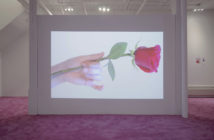Over the last twenty-three years, the Isabella Stewart Gardner Museum has enjoyed a lasting, reciprocal relationship with French artist Sophie Calle. While exhibiting work at the ICA/Boston in 1990, Calle took an interview with Parkett magazine in front of one of her favorite paintings, the Gardner's The Concert by Jan Vermeer. A short time later, that painting was cut from its canvas and removed by burglars dressed as Boston Police officers on March 18, 1990. When she learned of the theft, Calle phoned Gardner Director Anne Hawley to offer her condolences. "Her call was like an angel," recalls Hawley.
Hawley's initial phone conversation with Calle resulted in Last Seen... (1991), a project of photographic and text based works documenting the place from which each of the 13 objects were stolen alongside museum staff's recollections of them. While these photographs are straightforward and unadorned by aesthetic, Last Seen... ultimately evoke just how personal cultural loss is. Sophie Calle: Last Seen presents these 1991 works with What Do You See? (2013), another photographic and text based project that considers not only the act of theft, loss itself. Consisting of photographs documenting the space from which the objects were stolen, What Do You See? features human presence in the form of a shadow, or the back of a head, alongside musings on the theft by museum staff and visitors alike. Together, these two bodies of work articulate Calle's career-long consideration of loss and how it affects our lives, as well as her particular intimacy with the Gardner.
"I see a frame that makes the absence of the painting striking," reads the text from What Do You See? (Rembrandt, The Storm on the Sea of Galilee). "It's hard to imagine a painting, because it's gone....They want to make us believe it's not." Presumably the words of a museum visitor, this sentiment expresses the essence of What Do You See?, a work that emphasizes the experience of absence, as opposed to absence itself. Emptiness is a theme here, but further, Calle is exploring how we live emptiness. "My work is often about absence: of a lover, a parent, a friend, or of something else that is missing," explains Calle in a press release. "What is interesting here is how the absence was emphasized and made visible in such a striking way." That Calle and the visitor chose to describe both the theft and their relationship to how the Gardner has articulated it (via the empty frames) using similar speech demonstrates the universality of loss. What we loose becomes a memory, and we share our memories through words or images; we live with our memories through our relationship with sign and symbol. In Last Seen, Calle effectively summons the scene of a crime through what others have seen.
Pieranna Cavalchini, the Gardner's Curator of Contemporary Art (who curated Last Seen), found the Gardner through Calle's work. "I discovered this museum through this work," Cavalchini said. "[The theft] is like an open wound...she's given us a portrait of this work." More than just a representation of the 13 missing works, Last Seen is a representation of their place in cultural and personal memory.
- Last Seen… Installation View Photo: Stewart Clements Photography © Sophie Calle / Artists Rights Society (ARS), New York / ADAGP, Paris.
- What Do You See? (Rembrandt, A Lady and Gentleman in Black), (detail), 2013 1 Lambda print and 1 lithograph on Rives BFK paper 2 panels, each: 26 7/8 x 39 7/8 in. (68.2 x 101.2 cm) Edition of 2 French, 2 English © 2013 Sophie Calle / Artists Rights Society (ARS), New York /ADAGP, Paris. Courtesy of Sophie Calle, Paula Cooper Gallery, New York, and Isabella Stewart Gardner Museum, Boston.
- Last Seen… Installation View Photo: Stewart Clements Photography © Sophie Calle / Artists Rights Society (ARS), New York / ADAGP, Paris.
- What Do You See? (Vermeer, The Concert), (detail), 2013 1 Lambda print and 1 lithograph on Rives BFK paper 2 panels, each: 26 7/8 x 39 7/8 in. (68.2 x 101.2 cm) Edition of 2 French, 2 English © 2013 Sophie Calle / Artists Rights Society (ARS), New York / ADAGP, Paris. Courtesy of Sophie Calle, Paula Cooper Gallery, New York, and Isabella Stewart Gardner Museum, Boston.
Sophie Calle: Last Seen is on view through March 3, 2013.








